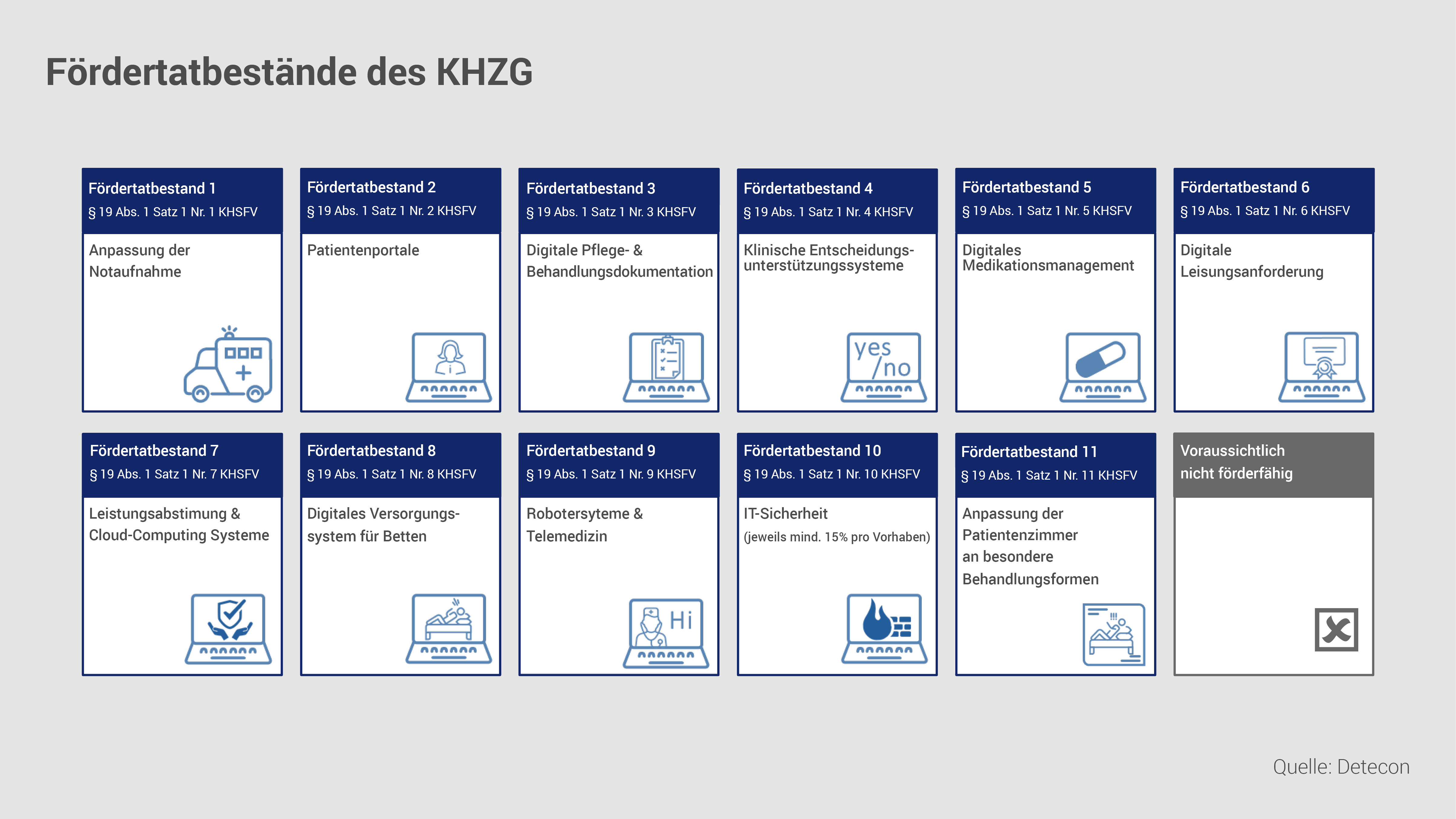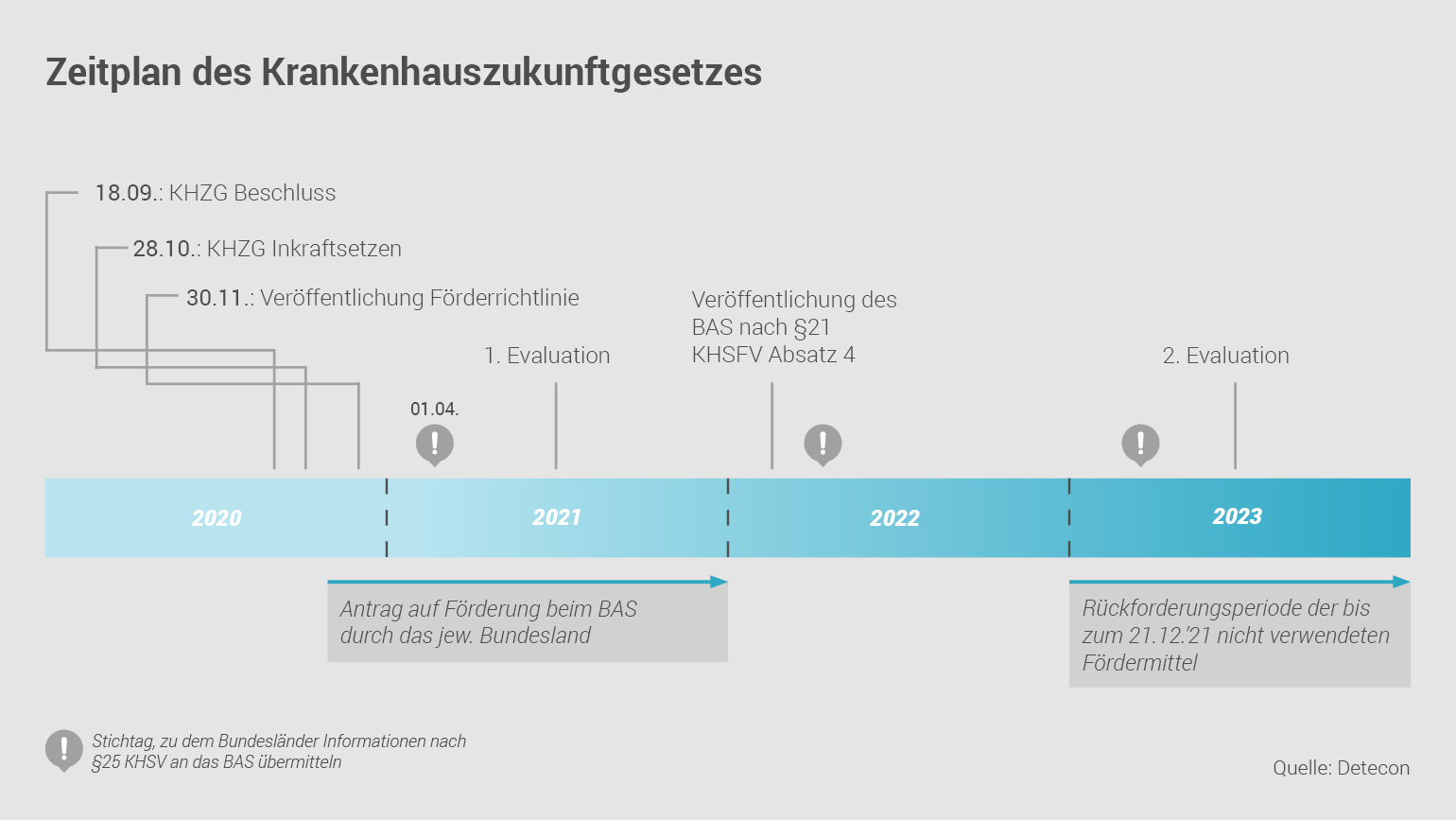Hospitals in Germany have an insufficient level of digitalization. In this country, the level of maturity of digitalization in the health care sector is very low in comparison with other European countries. According to the Electronic Medical Record Adoption Model (EMRAM), Germany achieves a score of 2.3 — in comparison, the European average is 3.6 (per 2019). Can the KHZG provide start-up assistance here?
To counteract the lack of digitization, Germany enacted the Hospital Future Act (KHZG) on 28.10.2020. An investment programme designed to provide modern equipment and digitised processes in hospitals.
Key figures on the KHZG
The investment program includes modernization measures predefined by the federal and state governments that relate to eleven funding categories (see Figure 1).
Both mandatory and optional criteria are defined in the respective funding facts, which must be complied with in accordance with the Hospital Structure Fund Ordinance (Section 19 (1) Sentence 1 No. 3 KHSFV). A sum of three billion euros has been made available for the investment project, which will be distributed to the respective federal states according to the Königstein Key (taking into account tax revenue and population size). In addition, 1.3 billion euros are to be contributed by the hospitals and/or from state funds to the implementation projects.
Funds are allocated on a "first come, first serve" basis. For this reason, the funding must be applied for as quickly as possible. In addition, it was decided that at least 15% of each individual grant must relate to measures to strengthen IT security.

If a hospital does not provide all of the digital services listed in Section 19 (1) Sentence 1 Numbers 2 to 6 of the Hospital Structure Fund Ordinance, a discount of up to two percent will apply for each full and partial inpatient case from January 01, 2025, regardless of whether or not funding has been claimed.
How to use the KHZG funds correctly
The federal states all had different deadlines for submitting requirements. The earliest dates were set for the end of January 2021. As a result, in most states the deadline for submitting the statement of requirements expired very early.
All funding applications must be received by the pertinent offices by the end of 2021 at the latest and realized by the end of 2023. Hospitals that have not completed targeted projects by that date face a penalty of two percent per full and partial inpatient case.
A rapid response by hospitals was essential. In the meantime, the first hospitals have received funding and started implementing their digitalization projects.

The hospitals’ view of the KHZG
Detecon has assisted several institutes during the application and project planning process. The work led to a series of interviews with several hospitals from different federal states revealing fascinating perspectives on the challenges and opportunities presented by the KHZG. (Rhineland-Palatinate, North Rhine-Westphalia and Hesse)
One thing is clear: even though the objectives of the act point in the right direction, the overall procedure could have been improved by more thoughtful planning in advance. While the KHZG provides funding by the federal government, the funding specifications (“rules of the game”) were set independently by each state. The federalist structure made the application process more complex and left less time for some hospitals than for others. In addition, hospitals had many questions concerning the application and concerns about not satisfying the plethora of requirements.
The KHZG made hospitals painfully aware of their lag in digitalization, which is why they were pleased with the funding opportunity that had been created and the specification of funding categories (see Figure 1). Without this support, many hospitals would struggle to get the ball rolling. The backlog in development is being addressed nationwide, strengthening Germany across the board — a commendable project.
Hopes for the German EMRAM benchmark
Mit dem KHZG hat Deutschland den ersten Schritt gemacht, die lang verschlafene Digitalisierung von Krankenhäusern bundesweit voranzutreiben. Zuträglich ist ebenfalls der EMRAM-Score (Electronic Medical Records Adoption Model), deren Überprüfung sich von ca. 2.000 deutschen Krankenhäusern aktuell weniger als zehn Prozent unterzogen haben (Quelle: Krankenhaus-Report 2019).
EMRAM (Electronic Medical Records Adoption Model) measures the level of digitalization of hospitals worldwide and ranks them according to values from 0 to 7. (0 = no digitalization; 7 = paperless hospital) (Source: Krankenhaus-Report 2019).
Germany’s adoption of the KHZG represents the first step aimed at driving forward the long-ignored digitalization of hospitals nationwide. The EMRAM score is also a valuable indicator; less than ten percent of approximately 2,000 German hospitals have currently undergone this review (Source: Krankenhaus-Report 2019).
For the future, the aim is to satisfy all applications from the earmarked funds and to secure the success of the projects in the hospitals. We hope that there will be further funding in the future so that hospitals can continue to finance their digitalization projects once they have been successfully launched.
Otherwise, it will not be possible to raise sustainably the level of digitalization in German hospitals to that of the European EMRAM standard as a minimum. Since the EMRAM score is provided to hospitals across Germany, the mean score should also increase in the future.









